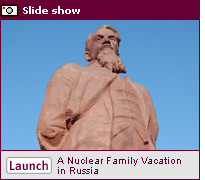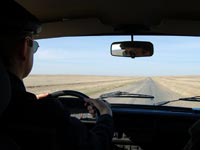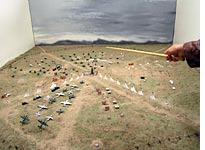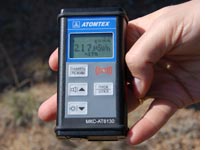A Nuclear Family Vacation in Russia
"I'll tell you what kind of anti-radiation measures we took," he said with a smile. "The main one was alcohol, pure distilled spirit. Before every test, we drank grain alcohol."
Kuklev, who worked for the Goskomgidromet, the unpronounceable Soviet state meteorological service, said he and his colleagues were given radiation suits and gas masks, but they tossed the burdensome equipment aside. The nuclear tests were often conducted at 10 a.m. Moscow time (noon in eastern Kazakhstan), so, as a prophylaxis, Kuklev and his co-workers would start drinking the night before.
Whether or not test-site employees were impervious to fallout thanks to a dose of folk medicine, they were still in better shape than Kazakhs living in nearby villages. During the tests, local residents went about their business, oblivious to the dangers of radiation. They had no idea that the Soviet military was conducting nuclear tests.
Starting in 1949, the Soviets detonated 456 nuclear devices at the Semipalatinsk Test Site. Kurchatov, located at the edge of the site, housed thousands of workers involved in the classified effort. The town belonged to the Soviet Union's network of secret cities, territories off-limits to the outside world that housed classified weapons research.
Local villagers wouldn't find out about the tests until 1991, the year the Soviet Union dissolved and Kazakhstan reluctantly became independent. The general in charge of the Semipalatinsk complex donated the former residence of Lavrenty Beria (who supervised the Soviet atomic bomb program for Stalin) to the Russian Orthodox Church; the scientists and technicians of Kurchatov—most of them from Russia—packed their bags and returned home. The Russians, as locals now like to say, took everything but the glass in the windows.
When we visited Kurchatov this spring, it still looked like a marauding army had recently passed through. Rows of derelict housing and collapsed facades lined the streets. The city, named after the Russian scientist who led the Soviet Union to nuclear glory, was a shell of its former self—an atomic ghost town.
Once inhabited by about 50,000 atomic workers, Kurchatov now has only 10,000 residents. By the mid-1990s, things really bottomed out. Almost worthless apartments were going for as little as $200, and no one thought the town had much of a future.
But newcomers are trying to revive the place. Kurchatov's second life as a Kazakh city began on Aug. 29, 1991, the day that Nursultan Nazarbayev, president of the newly independent country, decreed that the test site—a symbol of Soviet exploitation—would be closed. Less than a year later, Nazarbayev ordered the creation of Kazakhstan's National Nuclear Center, which would occupy the building and institutes once used by weapons scientists. Kurchatov was back in business, this time with Kazakh scientists and grand plans to build a "technopark" devoted to the peaceful use of nuclear technology.
The problem was, the Russians also took all the test data with them when they left. So, for the Kazakhs, studying the effects of nuclear radiation is an uphill effort.
The day after our arrival, we took a guided tour of the test site, or "polygon" as it's generally referred to in Russian. Our guide, Yuriy Strilchuk, arrived wearing old fatigues, fashionable aviator sunglasses, and a camouflage hat. He was carrying a hand-held dosimeter—something we hadn't seen on our trip last year to the Nevada Test Site.
Much as in the United States, the Soviets tested their nuclear weapons on everything from buildings and bomb shelters to military hardware and live animals. At the museum of nuclear testing in Kurchatov, our guide showed us a diorama straight out of a junior-high-school history contest. It depicted how the Soviets arranged the 1949 testing ground in sectors around ground zero: livestock in one, a mock village in the next, military aircraft in another, and so on. The remnants of those tests—pieces of concrete and twisted rebar—now mingle freely with recent refuse: a random boot missing its laces, a broken beer bottle, some horse droppings.
As we traveled toward the center of the polygon, Strilchuk's dosimeter gave us a constant reading of the radiation, confirming that the levels were at background—less than 10 microroentgens per hour—for the better part of our trip. But as we moved closer to the epicenter, the number on the readout slowly crept up. Around 220 yards from ground zero, the dosimeter gave a reading of 66 microroentgens. A few steps farther, and the display jumped to 600 microroentgens—a level Strilchuk compared to getting a chest X-ray. When we finally reached ground zero, the dosimeter spiked to more than 2,000 microroentgens per hour. Strilchuk warned us not to linger there for more than 10 or 15 minutes.
It was here that the Soviets detonated their first nuclear device in 1949, just four years after the Trinity test in New Mexico. The Americans dubbed that test Joe-1, after Joseph Stalin, but the Soviets coded it RDS-1, which in popular lore stands for Reaktivny Dvigatel Stalina, or Stalin's Rocket Engine. But the real provenance of the name remains a mystery, perhaps even to the Russians. In one joint meeting between the Kazakhs and the Russians in the 1990s, scientists from both sides attempted to get to the bottom of the mystery but only came up with more variations: Rossiya delaet sama ("Russia does it herself"), or Rossiya daet sdachu ("Russia strikes back"). No one really knew for sure, Strilchuk said.
Another unknown was the effect of the radiation. Radiophobia, as Russians like to call fear of radiation, affects everyone differently. Strilchuk recalled with some amusement how German journalists arrived at the test site equipped with ventilators, and how Polish TV producers were afraid to get out of their cars. But others were fearless to the point of absurdity. One Scandinavian camera operator lay down in the radioactive dirt to get a better shot of ground zero.
At the epicenter, we saw pieces of molten rock (named kharitonchiki after one of the leading Russian nuclear weapons scientists, Yuly Khariton). The porous black pebbles were less pretty than American Trinitite but equally intriguing. We were politely rebuked when we picked up a piece ("Just because I pick it up, doesn't mean you should," Strilchuk said). According to our guide, they were still dangerous to handle.
Was a kharitonchik any more radioactive than a piece of Trinitite? How much was myth and how much was reality almost didn't matter. The secrecy surrounding nuclear testing created a climate of distrust.
Zhenis Zhotabayev, the current director of science at the newly created National Nuclear Center, explained why suspicion lingers. "The polygon was off limits, the city was closed," he said. "And the people who lived here had a Moscow standard of living: kielbasa, butter, everything. But in the surrounding villages, they had nothing."
The Soviets might have shuddered at the thought of Zhotabayev, who looks like a Kazakh version of American physicist Richard Feynman, sitting in the director's chair. Though a nuclear engineer by training, Zhotabayev would have been an unlikely candidate to work on the Soviet nuclear weapons program, which favored ethnic Slavs.
Is there any cooperation with Russia today, we asked? Zhotabayev said there was help dismantling some infrastructure, but when it came to data that could help map out the extent of radioactive contamination—and differentiate between fact and fiction—the Kazakhs got squat.
"Russia hasn't given us anything," he laughed. "To be completely frank, we are starting here from zero."
******
Endnote: Visitors can request permission to visit Kurchatov through the National Nuclear Center, which arranges official tours. According to Lonely Planet's Central Asia guidebook, tourists can also simply hop a cab from the neighboring city of Semipalatinsk, thus bypassing any formalities.



